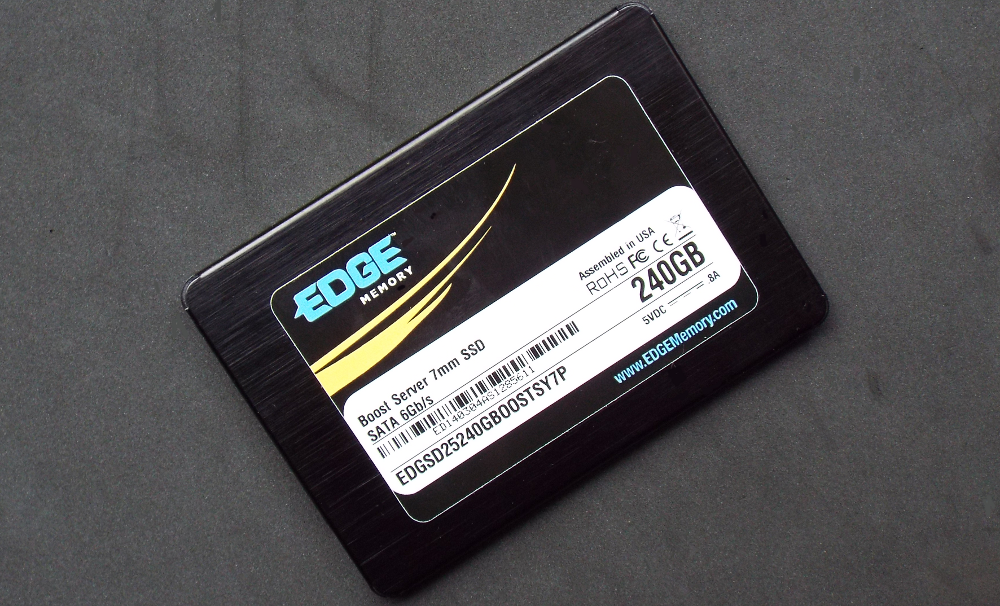Edge Memory is a leading supplier of DRAM memory and other flash-based devices, including solid-state drives (SSDs). Back in February, we reviewed their diskGO Super-speed USB 3.0 pocket SSD. While offering a variety of consumer-level products, Edge’s expertise and passion are focused on the enterprise market and corporate-level projects.
Edge is best known for their “Boost” series of both client and enterprise SSDs. Today we have on hand the 240GB version of the Edge Boost Server 7mm SSD.
INTRODUCTION
Geared toward servers and data centers, the Edge Boost Server 7mm SSD utilizes an enterprise-level LSI-SandForce controller to achieve strong read/write and IOPS speeds. The SATA 6 Gb/s interface is rated to achieve up to 560 MB/s sequential reads and 530 MB/s sequential writes (240GB model — other capacities vary). Random 4K read speeds are stated as 45,000 IOPS, with random 4K write speeds of 80,000 IOPS (240GB model — other capacities vary).
The Edge Boost Server 7mm SSD features on-board capacitors to enable and support power-fail protection to prevent data loss in the event of a power failure or interruption. It also features 128-bit AES encryption and secure erase capabilities. The Boost Server 7mm also supports TRIM, S.M.A.R.T., DuraWrite, RAISE and garbage collection. Error detection and correction and wear-leveling functions are also included.
Power consumption for the Edge Boost Server 7mm is stated as 3w (active) and 1w (idle). Edge Memory offers quite a variety of capacity points for the Boost Server 7mm SSD — 50GB / 100GB / 120GB / 160GB / 200GB / 240GB / 300GB / 360GB / 400GB / 480GB. Mean Time Between Failures (MTBF) is stated as 2,000,000 hours, and Edge Memory backs this SSD with a five-year warranty.
PACKAGING AND CONTENTS
The Edge Boost Server 7mm SSD is offered up in an attractive, predominantly glossy black package. The SSD itself is secured inside a clear plastic clamshell, and shows clearly through the large window in the front of the package. A “SandForce Driven” logo is also present. The rear lists the “Fast”, “Robust” and “Durable” benefits of upgrading to an Edge Boost SSD. Also present on the rear is a model number and serial number label, and again the “SandForce Driven” logo.
Once we remove the Edge Boost Server 7mm SSD from its packaging, we find a gloss black aluminum case with a large label that is similar to the exterior packaging itself. The label also indicates capacity, model number and serial number. The bottom half of the black aluminum case is free of any labels or markings.
COMPONENTS
Once we remove the four tiny screws (two per long side) that hold the two halves of the aluminum case together, we can separate the halves and reveal the printed circuit board. We are seeing the NAND side of the circuit board, and two things immediately catch our eye — first is the rows of yellow capacitors that enable and provide power fail protection; and second is that the circuit board is actually screwed to the lower half of the aluminum case with another four small screws. For enterprise-level durability, this is preferable to merely being cushioned or trapped between the case halves.
After removing the four screws securing the circuit board to the lower half of the case, we can flip it over to see the controller side. Our first look at the controller finds it hidden underneath an adhesive-backed thermal pad (for dissipating controller heat to the aluminum case). After removing the thermal pad and adhesive left behind, we find an LSI-SandForce SF-2581 controller.
The LSI-SandForce SF-2581 NAND controller is targeted to enterprise boot applications. It is an 8-channel controller that can support up to 512GB of NAND. The SF-2581 also supports extended S.M.A.R.T. attributes for drive health monitoring, AES encryption, and has power-fail circuit support. The SF-2581 requires a minimum of 7% over-provisioning. The process of removing the excess adhesive left behind from removing the thermal pad renders the controller a bit difficult to obtain a sharp photo of.
Getting back to the NAND side of the circuit board, we find a total of 8 X 32GB NAND modules. We suspect that the NAND being utilized is from Toshiba, but we were unable to confirm that prior to publication. Edge Memory’s product page for the Boost Server 7mm lists the NAND as MLC synchronous, but no other NAND specifics are provided. Edge Memory has advised that this is 19nm toggle NAND, but they are under NDA with the NAND manufacturer as far as releasing any other specifics.
 The SSD Review The Worlds Dedicated SSD Education and Review Resource |
The SSD Review The Worlds Dedicated SSD Education and Review Resource | 


Another day, another sandforce drive 🙂
although its nice to see power loss capacitors on more drives..